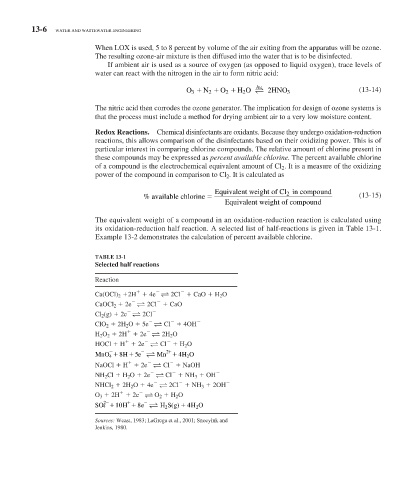Page 511 - Water and wastewater engineering
P. 511
13-6 WATER AND WASTEWATER ENGINEERING
When LOX is used, 5 to 8 percent by volume of the air exiting from the apparatus will be ozone.
The resulting ozone-air mixture is then diffused into the water that is to be disinfected.
If ambient air is used as a source of oxygen (as opposed to liquid oxygen), trace levels of
water can react with the nitrogen in the air to form nitric acid:
hv
O 3 N 2 O 2 H O 2 (13-14)
2 HNO 3
The nitric acid then corrodes the ozone generator. The implication for design of ozone systems is
that the process must include a method for drying ambient air to a very low moisture content.
Redox Reactions. Chemical disinfectants are oxidants. Because they undergo oxidation-reduction
reactions, this allows comparison of the disinfectants based on their oxidizing power. This is of
particular interest in comparing chlorine compounds. The relative amount of chlorine present in
these compounds may be expressed as percent available chlorine. The percent available chlorine
of a compound is the electrochemical equivalent amount of Cl 2 . It is a measure of the oxidizing
power of the compound in comparison to Cl 2 . It is calculated as
Equivalent weight of Cllin compound
% available chlorine 2 (13-15)
Equivalent weight of compound
d
The equivalent weight of a compound in an oxidation-reduction reaction is calculated using
its oxidation-reduction half reaction. A selected list of half-reactions is given in Table 13-1 .
Example 13-2 demonstrates the calculation of percent available chlorine.
TABLE 13-1
Selected half reactions
Reaction
Ca(OCl) 2 2H 4e 2Cl CaO H 2 O
CaOCl 2 2e 2Cl CaO
Cl 2 (g) 2e 2Cl
ClO 2 2H 2 O 5e Cl 4OH
H 2 O 2 2H 2e 2H 2 O
HOCl H 2e Cl H 2 O
2
MnO 4 8 H 5e Mn 4H O
2
NaOCl H 2e Cl NaOH
NH 2 Cl H 2 O 2e Cl NH 3 OH
NHCl 2 2H 2 O 4e 2Cl NH 3 2OH
O 3 2H 2e O 2 H 2 O
2
()
SO 4 10 H 8 e H S g 4 H O
2
2
Sources: Weast, 1983; LaGrega et al., 2001; Snoeyink and
Jenkins, 1980.

